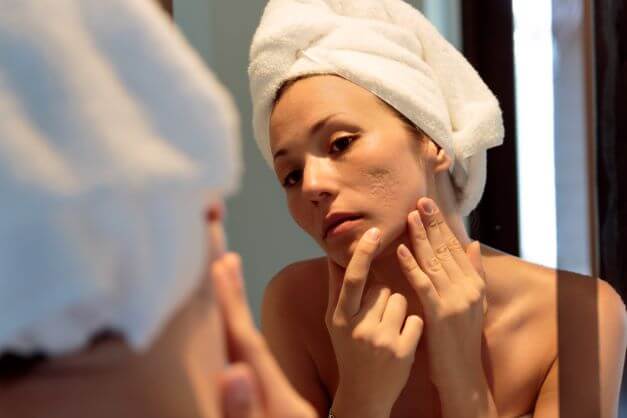Struggling with acne is often just beginning when you see a breakout. The effects of acne on skin health and overall well-being can be long-lasting. Scarring is one of the most common long-term effects of acne. According to Dr. Mahsa Karavan of U.S. Dermatology Partners in Plano, Texas, “Acne breakouts can mar the appearance in the short term, but acne scars can make this negative impact on the skin permanent. When scarring occurs, there are dermatologic treatments and skincare products that can help reverse the damage, but there are also steps you can take to minimize the number and severity of acne scars during an active breakout.” Keep reading to learn more from Dr. Karavan about steps to minimize acne scars and available treatments to improve the appearance of acne scars.
What Causes Acne Scars?
Acne is a chronic skin condition that causes pores to become clogged with oil, dead skin cells, bacteria, and other matter. This condition is often associated with adolescence when changes in hormone levels result in the increased production of sebum, the body’s natural oil. In addition to the hormonal shifts that occur during the teenage years, changes in hormones during pregnancy, menopause, and times of stress can also lead to acne breakouts. There are some other causes of acne, including taking certain medications or improper hygiene, but the vast majority of acne breakouts occur as a direct result of changes in hormone levels.
When it comes to the underlying causes of scarring, Dr. Karavan says, “Not everyone who has acne will develop acne scars. Some people are just more prone to scarring. Others end up with scars because they have larger blemishes like pustules, papules, nodules, or cysts. These types of pimples are much more likely to cause scar tissue to develop as they can damage the healthy skin on the surface as well as deeper layers of skin, making it harder for the body to heal while maintaining an appearance that blends with surrounding skin.”
Are there Different Types of Acne Scars?
There are two main types of acne scars: hypertrophic and atrophic (also called fibrotic scars). Hypertrophic raised acne scars typically occur when acne breakouts cause inflammation and irritation that impacts the blemish itself and the surrounding skin. The inflammation causes the skin to overproduce new cells, causing a bump to form. The second type, fibrotic depressed acne scars, are actually the most common form of acne scars. They occur when a blemish destroys healthy skin cells below the blemish, leaving a pit or indentation on the surface skin. Another common acne scar is called a macule. Macules cause the skin to redden in the area where a blemish is healing. This type of scarring typically fades on its own within a few weeks or a month. Post-inflammatory hyperpigmentation, another type of skin discoloration, can also occur as a result of acne breakouts. In some cases, it will also clear on its own, but post-inflammatory hyperpigmentation may be permanent.
Can I Prevent Acne Scars?
To prevent acne scars Dr. Karavan recommends, “This might sound biased because I am a dermatologist, but truly one of the best ways to prevent acne scarring is to work with a dermatologist to develop a daily skincare routine to prevent or minimize the impact of breakouts. Finding the right products and following a regular skincare and acne treatment plan can make a huge difference in the number and severity of acne breakouts, which significantly decreases the risk for scarring.” In addition to following a dermatologist-recommended skincare routine for acne-prone skin, Dr. Karavan also recommends the following steps to prevent acne scars:
- Never pop pimples! – If you follow no other recommendation in this blog, please follow this one. We know pimple-popping videos are all the rage online, but popping pimples increases your risk for scarring in addition to causing increased irritation and inflammation that makes your pimples look worse during a breakout. Popping pimples can also lead to infection.
- Use spot treatments – A spot treatment can help clear up a pimple more quickly without popping it. One of our most recommended acne spot treatments was curated by U.S. Dermatology Partners’ team of experts. It’s the MD Skin Essentials Minimize It acne spot treatment. It helps to clear up blemishes, conceal the pimple during a breakout, minimize pores, and reduce oiliness.
- Apply cold compresses – For larger or deeper acne blemishes like cysts or nodules, there may be a lot of pain, swelling, and irritation. Applying a cool, clean cloth to the affected area a few times a day can help with inflammation and irritation as it heals.
- Visit a dermatologist for severe breakouts – If you’re having a breakout that doesn’t clear up as quickly as other acne flare-ups or you’re struggling with one or more deep cysts or other larger pimples, schedule a visit with your dermatologist. They can help you clear up the breakout more quickly and minimize the risk of scarring.
- Apply zinc-based sunscreen- UV rays could worsen scarring and lead to additional pigmentation from active acne, diligent sunscreen use can reduce the severity of acne scar formation.
What Treatments Are Available to Reverse Scarring?
According to Dr. Karavan, “Sometimes, you just can’t prevent scarring altogether. Certain people are more prone to developing scars than others, and there are situations where acne scars will happen despite your best preventive measures. When this happens, there are some dermatologic treatments available to minimize the appearance of acne scars. In most cases, treatment for acne scars is minimally invasive and generally pretty comfortable.” Some frequently recommended options to treat acne scarring include:
- Chemical peels – This treatment is ideal for pigmentation left behind from acne as well as mild atrophic scars, it is typically not adequate for moderate to severe acne scars and may not always be the safest option in darker skin tones. Over the course of a few treatments, this can significantly diminish the appearance of acne scars.
- Microneedling – There are two forms of microneedling. Traditional microneedling involves using small needles to make microscopic injuries in the surface of skin. This stimulates healing and reduces the appearance of scars. There is also a form of microneedling that combines this treatment with radio frequency technology. The radio frequency technology uses heat to better stimulate the production of collagen and elastin. Both forms of microneedling work best for the treatment of mild to moderate atrophic scars and are effective for most skin shades.
- Laser treatments – This option is often recommended for scarring that doesn’t respond to microneedling or chemical peels, or if acne scars are more severe Lasers can be targeted to remove skin cells of a certain pigmentation, making them a great option for post-inflammatory hyperpigmentation. Laser treatments can help restructure and rebuild collagen networks under the scars to smooth the texture.
- Dermal fillers – For atrophic scars, a dermal filler can be used to restore the fullness of the depressed pit or groove caused by the acne scar, smoothing the skin’s surface. This treatment is long-lasting, but not permanent. Certain fillers that are also known to stimulate collagen production can be utilized to not only temporarily improve scar texture, but over time to build healthy new collagen fibers for longer lasting results. Depending on the individual, retreatment may be recommended several times a year.
- Retinoic acid therapy – This treatment may be applied after severe acne breakouts or pimple extractions to prevent scarring. It can also be used to diminish the appearance of acne scars, especially for those who are prone to keloid scarring that can be made worse by the traditional methods of scar removal.
- Subcision- This is a surgical procedure for deeper acne scars including icepick scars. The procedure uses a special needle to cut and release fibrotic bands underneath the atrophic scars, leading to a restructuring of the abnormal collagen bands and improvement in surface texture. This procedure can be combined with microneedling or laser treatments, and often needs repetition.
How Do I Get Started Working with U.S. Dermatology Partners?
If you struggle with acne, you should work with a dermatologist to create an effective skincare routine to prevent acne breakouts and maintain healthier skin. The U.S. Dermatology Partners team can help you develop an acne skincare routine that will minimize your risk for breakouts and scarring. They can also work with you to find effective dermatologic treatment options to address acne scars. When you’re ready to get started, take a few moments to complete our simple scheduling request form. Once our team members hear from you, they’ll be in touch to finalize all of your appointment details.
Find a location near me
or


